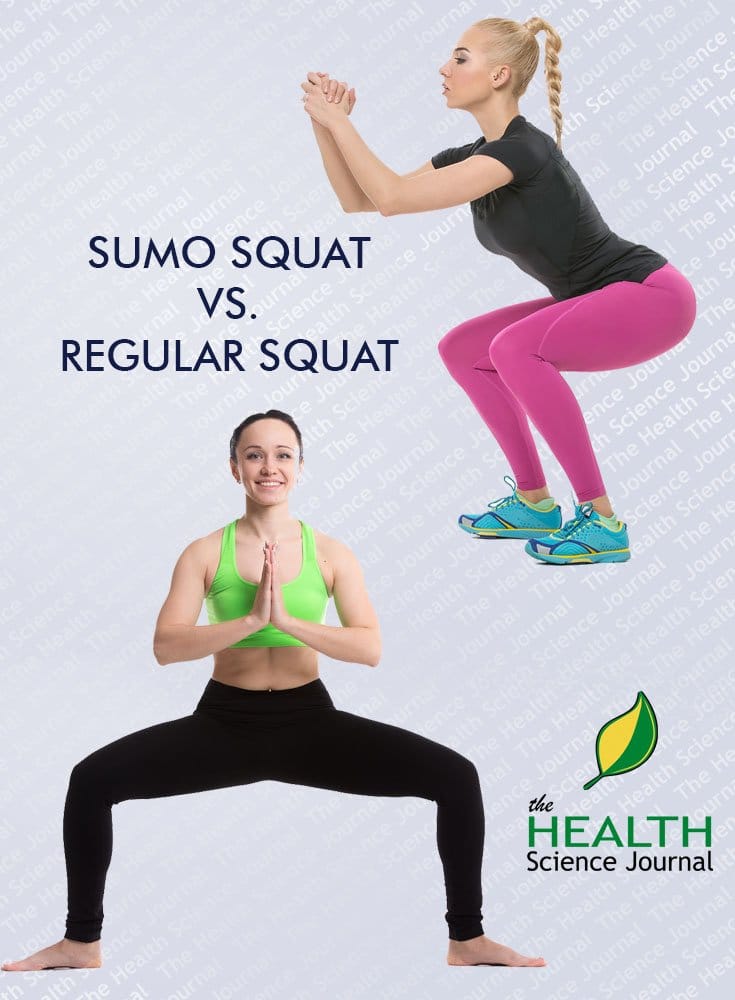The squat is a powerful exercise. It works 75% of your muscles in a single movement and it should be one of the mainstays in any leg workout. It’s undeniable ability to make your muscles grow faster and stronger in less time than most other compound movements is why it’s a part of the training routines of pro athletes and average gym-goers alike. As a matter of fact, athletes from every sport and discipline use some version of this exercise to tone their legs and abs, strengthen their core and improve their overall performance (1,2,3). So, which one should you do, sumo squats or regular squats? Let’s compare!
There are many versions of the regular squat that you can include in your training routine to increase gains on specific muscles. Among them, the sumo squat may be the best exercise for building strength in the glutes and inner thighs.
The main difference between regular and sumo squats is the placement of your feet, which naturally leads to a different muscle emphasis. During a regular squat, the feet are placed hip-width apart and the toes face forward or slightly out. For a sumo squat, the feet should be in a wide stance with the toes turned out at an even greater angle. Though both variations work the glutes, hamstrings, quadriceps, hip flexors and calves, sumo squats place more stress on the inner thigh adductors and glutes.
Regardless of which squat version you choose to do, make sure you perform the entire movement in a slow, controlled manner for optimal results.
Mastering the Regular Squat
Before attempting the sumo squat, it’s important to master the proper form and technique of the standard squat.

Stand up straight and place your feet slightly wider than shoulder-width apart, hips stacked over knees and knees over ankles. Roll the shoulders down, straighten your back and extend the arms until they’re parallel with the ground, palms facing down. Inhale and bend your knees, bringing the hips backwards and down until your thighs are parallel to the floor, or even lower. While the butt starts to stick out, make sure the chest and shoulders stay upright, the head facing forward with eyes straight ahead for a neutral spine. At the bottom of the squat, the knees should be directly over your toes. Remember to keep your feet anchored firmly to the ground all throughout the movement. Exhale, engage your core and, with bodyweight in the heels, explode back up to standing, driving through heels.
Upgrading to the Sumo Squat
After you have mastered the traditional squat, you can try the sumo variation.
Start by standing with your feet significantly wider than shoulder-width apart (about three to four feet) and toes turned out at an angle of 45 degrees. Inhale, bend your knees and push your hips back while keeping the chest up, abs tight and back straight. Lower yourself down by bending your knees and hips, raising your hands to meet under your chin. Keep your abs tight, back straight and do not let your knees move past your toes when lowering. The weight should be concentrated in the glutes and inner thighs. Once your thighs are parallel to the floor, exhale and root through your heels and rise back up steadily for one rep. Again, don’t let your heels lose contact with the floor, keep the knees parallel with the toes and keep your whole back perfectly straight throughout the entire movement.

Only after you’ve mastered both squats and perfected the form, you can use added resistance to increase the challenge and work on building strength. One basic way to increase the resistance for squats is by holding a barbell behind your head and across your upper back and shoulders (back squat). Hold the barbell at the same height, but resting on your chest and the front of your shoulders for a front squat, or hold the barbell overhead for an overhead squat.
If you only have access to dumbbells, hold one dumbbell with both hands in front of you, or you can hold a dumbbell or a kettlebell in the center of your chest with both hands to perform a goblet squat. You might even try adding one of the longer resistance bands to your squat variations. Stand in the middle of the band and hold both handles at shoulder height as you do your squats, focusing more of your effort on the raising than the lowering.
Finally, to answer our question: sumo squats or regular squats? Answer: Both!
Enjoy your squatting and please share!


